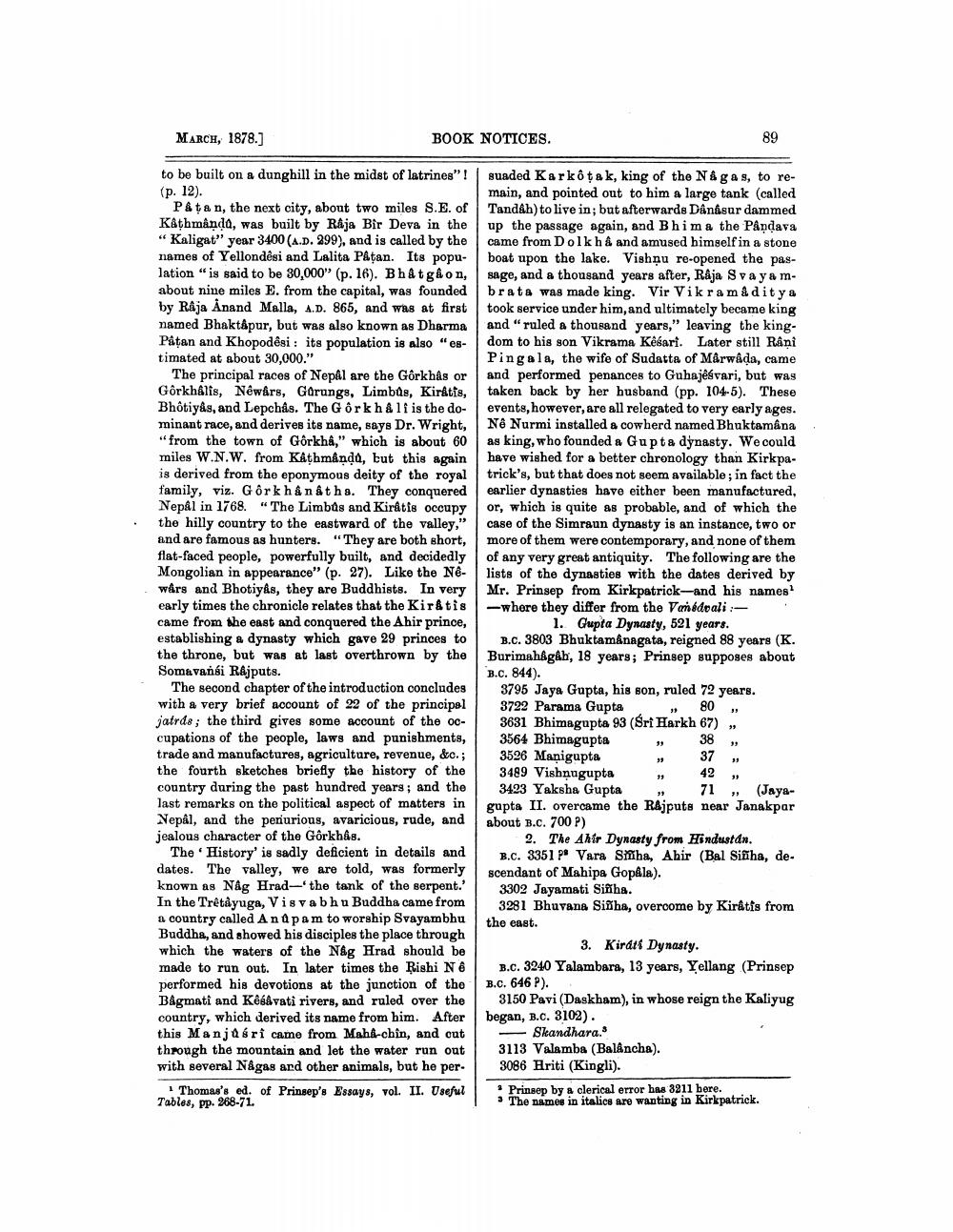________________
MARCH, 1878.]
BOOK NOTICES.
to be built on a dunghill in the midst of latrines" ! (p. 12).
P&ta n, the next city, about two miles S.E. of Kathmandd, was built by Raja Bir Deva in the “Kaligat” year 3400 (A.D. 299), and is called by the names of Yellondêsi and Lalita Påtan. Its population "is said to be 30,000" (p. 16). Bhåtgaon, about nine miles E. from the capital, was founded by Raja Anand Malla, A.D. 865, and was at first named Bhaktapur, but was also known as Dharma Patan and Khopodesi : its population is also "estimated at about 30,000."
The principal races of Nepál are the Gôrkhas or Görkhålis, Néwårs, Gorungs, Limbus, Kirátis, Bhôtiyâs, and Lepchâs. The Gorkhali is the dominant race, and derives its name, says Dr. Wright, "from the town of Gorkha," which is about 60 miles W.N.W. from Kathmanda, but this again is derived from the eponymous deity of the royal family, viz. Gorkha nåtha. They conquered Nepal in 1768. "The Limbus and Kirátis occupy the hilly country to the eastward of the valley," and are famous as hunters. "They are both short, flat-faced people, powerfully built, and decidedly Mongolian in appearance" (p. 27). Like the Ne- wars and Bhotiyâs, they are Buddhists. In very early times the chronicle relates that the Kirátis came from the east and conquered the Ahir prince, establishing a dynasty which gave 29 princes to the throne, but was at last overthrown by the Somavansi Rajputs.
The second chapter of the introduction concludes with a very brief account of 22 of the principal jatrds; the third gives some account of the occupations of the people, laws and punishments, trade and manufactures, agriculture, revenue, &c.; the fourth sketches briefly the history of the country during the past hundred years; and the last remarks on the political aspect of matters in Nepal, and the periurious, avaricious, rude, and jealous character of the Gôrkhas.
The History' is sadly deficient in details and dates. The valley, we are told, was formerly known as Nag Hrad—the tank of the serpent.' In the Trêtåyuga, Visvabhu Buddha came from a country called Anupam to worship Svayambhu Buddha, and showed his disciples the place through which the waters of the Nag Hrad should be made to run out. In later times the Rishi N 6 performed his devotions at the junction of the Bågmati and Kebavati rivers, and ruled over the country, which derived its name from him. After this Manjasri came from Mahl-chin, and cut through the mountain and let the water run out with several N&gas ard other animals, but he per
Thomas's ed. of Prinsep's Essays, vol. II. Useful Tables, pp. 268-71.
suaded Karkotak, king of the Nagas, to remain, and pointed out to him a large tank (called TandAh) to live in; but afterwards Dinasur dammed up the passage again, and Bhima the Påndava came from Dolkh & and amused himself in a stone boat upon the lake. Vishņu re-opened the passage, and a thousand years after, Raja Svaya mbrata was made king. Vir Vikramaditya took service under him, and ultimately became king and "ruled a thousand years," leaving the kingdom to his son Vikrama Kesari. Later still Rani Pingala, the wife of Sudatta of Marwada, came and performed penances to Gubajéávari, but was taken back by her husband (pp. 104-5). These events, however, are all relegated to very early ages. Nê Nurmi installed a cowherd named Bhuktamâna as king, who founded a Gupta dynasty. We could have wished for a better chronology than Kirkpatrick's, but that does not seem available; in fact the earlier dynasties have either been manufactured, or, which is quite as probable, and of which the case of the Simraun dynasty is an instance, two or more of them were contemporary, and none of them of any very great antiquity. The following are the lists of the dynasties with the dates derived by Mr. Prinsep from Kirkpatrick-and his names -where they differ from the Vañéduali:
1. Gupta Dynasty, 521 years. B.C. 3803 Bhuktamânagata, reigned 88 years (K. BurimahagAh, 18 years; Prinsep supposes about B.C. 844).
3795 Jaya Gupta, his son, ruled 72 years. 3722 Parama Gupta 1 , 80 3631 Bhimagupta 93 (Sri Harkh 67), 3564 Bhimagupta 3526 Manigupta
37 , 3489 Vishnugupta
42 » 3423 Yaksha Gupta , 71 (Jayagupta II. overcame the Rajputs near Janakpar about B.c. 700 ?)
2. The Ahir Dynasty from Hindustan. B.C. 3351 P Vara Smiha, Ahir (Bal Siñha, de. scendant of Mahipa Gopala).
3302 Jayamati Siñha.
3281 Bhuvana Siñha, overcome by Kiratis from the east.
3. Kiráti Dynasty. B.C. 3240 Yalambara, 13 years, Yellang (Prinsep B.c. 646 P).
3150 Pavi (Daskham), in whose reign the Kaliyug began, B.C. 3102).
- Skandhara. 3113 Valamba (Balâncha). 3086 Hriti (Kingli). • Prinsep by a clerical error has 3911 bere. 3 The names in italics are wanting in Kirkpatrick.
→
38
,




